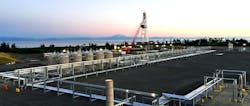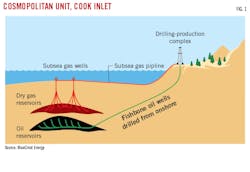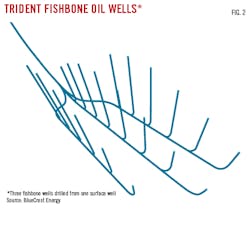BlueCrest adapts extended reach drilling for Alaska’s Cook Inlet
BlueCrest Energy, a privately owned independent based in Fort Worth, Tex., has adapted long-range drilling techniques to produce oil from the Cosmopolitan Unit in Alaska’s Cook Inlet near Anchor Point on the Southern Kenai Peninsula.
Development has been slow, partly because previous owners did not fully understand the resource. In 1967, Pennzoil encountered the edge of the oil sands but did nothing with it. ConocoPhillips directionally drilled a well into the Cosmopolitan sands in 2001 from onshore for lack of a jack up drilling rig. ConocoPhillips’ well did not penetrate most of the oil sands or any of the shallower gas sands.
BlueCrest was one of the first companies to drill offshore Alaska in 20 years when in 2013 it used a jack up rig in 80 ft of water in the Cook Inlet. BlueCrest confirmed over 1,000 ft of oil sands and 5,000 ft of gas sands about 3 miles offshore.
Currently, BlueCrest is drilling into Cosmopolitan from onshore using BlueCrest 1, a rig it designed and had built by Oderco with 3,000-hp drawworks, derrick load rating of 1.5 million lb, and a 750-ton top drive. The rig is arctic rated. A hydraulic jack slides the BlueCrest 1 from well to well on huge steel rails. Fig. 1 shows how BlueCrest uses rotary-steerable drilling to penetrate the formations with wells drilled from an onshore pad 3 miles away.
“We know that we have about 500 million bbl of oil in the field, but what we don’t know is how much of that oil we’ll eventually recover,” said Benjamin Johnson, BlueCrest chief executive officer.
Johnson called BlueCrest 1 the most powerful drilling rig in Alaska as of June 2019 but noted that ConocoPhillips is building a large extended-reach rig for the North Slope that will be more powerful. Fig. 2 shows BlueCrest’s onshore drilling-production complex.
The Cosmopolitan subsea reservoirs are stacked between 1,000-7,000 ft. vertical depth in 80 ft. of water. Long, angled wells have been drilled to 31,664-ft MD, Johnson said. BlueCrest began producing Cosmopolitan oil in 2016 and since has drilled another five wells.
Bluecrest initially planned a series of horizontal wells about 800 ft apart. Each well was to be hydraulically fractured in multiple stages to help oil flow from the thick, layered play, Johnson said. But fracturing proved more expensive and less effective than in other basins. Crews had difficulty targeting the fractures at the end of the long wells.
The company decided to instead drill through the reservoir layers coming up from under the oil. A plan evolved to drill multiple sidetrack wells offshore targeting specific layers with horizontal wells.
Fishbone wells enable BlueCrest to make numerous penetrations into Cosmopolitan with fewer main wellbores and without hydraulic fracturing. Johnson said drilling up through the layers provides better vertical reservoir contact than fracturing.
The technique makes the same penetrations as if the wells were drilled from the surface every 800 ft., and each fishbone configuration has about seven ribs (wells).
BlueCrest uses oil-based mud with very-low solids (calcium carbonate) to minimize formation damage.
Drillers start at the bottom and steer each 8-1/2” diameter rib upward 500 vertical ft to the top of the targeted oil zone at a 110° angle, then return to the bottom and sidetrack horizontally to initiate the next rib. Johnson anticipates drilling 15-18 of these fishbone wells to develop the two deepest oil zones.
The oil is in two groups of six known oil zones. The current production interval is Tyonek and Hemlock.
Johnson attributes the ability to drill up through the rock to its hardness, noting “this would probably not work with unconsolidated rock.”
The fishbone wells have increased Cosmopolitan oil production from less than 200 b/d in 2016 to 1,800-2,000 b/d in 2019. BlueCrest executives now plan to increase production by splitting future wells from a single intermediate casing string into three fishbones, each having its own ribs (a trident fishbone).
Fig. 3 shows a trident fishbone, which Johnson believes will accelerate drilling, improve efficiency, and lower cost. Each rib is 800 ft apart and each parallel fishbone is 800 ft apart, creating equivalent reservoir penetration as wells drilled from the surface on 16-acre spacing. BlueCrest is finalizing plans for drilling the first trident fishbone expected later in 2019.
The first fishbone well paid-out in only 11 months. Oil production could reach 3,000-4,000 b/d within 18 months, and long-term rates could exceed 8,000 b/d, BlueCrest is likely to add injection wells to maintain reservoir pressure.
BlueCrest owns and operates Cosmopolitan with 100% working interest on six Alaska state leases covering 20,367 acres offshore and a 38-acre onshore surface lease. The company obtained 3D seismic data in 2005 covering 40 sq miles, covering the entire project area.
The offshore gas wells contain no liquid hydrocarbons and produce dry gas from Upper Tyonek sands that are too shallow to reach from shore. Johnson expects to develop the gas using subsea completions of 8-20 wells drilled from offshore. There are more than six known gas zones but more could be found through additional drilling.
About the Author
Paula Dittrick
Senior Staff Writer
Paula Dittrick has covered oil and gas from Houston for more than 20 years. Starting in May 2007, she developed a health, safety, and environment beat for Oil & Gas Journal. Dittrick is familiar with the industry’s financial aspects. She also monitors issues associated with carbon sequestration and renewable energy.
Dittrick joined OGJ in February 2001. Previously, she worked for Dow Jones and United Press International. She began writing about oil and gas as UPI’s West Texas bureau chief during the 1980s. She earned a Bachelor’s of Science degree in journalism from the University of Nebraska in 1974.




